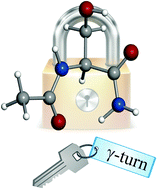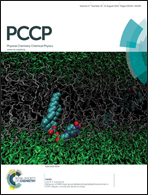Fourier transform microwave spectroscopy of Ac-Ser-NH2: the role of side chain interactions in peptide folding†
Abstract
Serine capped dipeptide N-acetyl-L-serinamide (Ac-Ser-NH2) has been investigated using Fourier transform microwave spectroscopic techniques combined with laser ablation sources. Spectral signatures originating from one dominant species have been detected in the supersonic expansion. Rotational and nuclear quadrupole coupling constants of the two 14N nuclei have been used in the characterization of a Ceq7/γ-turn structure, which is stabilized by a CO⋯HN intramolecular hydrogen bond closing a seven-membered ring. Two extra hydrogen bonds involving the polar side chain (–CH2OH) further stabilize the structure. The non-observation of C5 species, attributed to the presence of the polar side chain, is in contrast with the previous gas phase observation of the related dipeptides containing glycine or alanine residues. The A–E splitting pattern arising from the internal rotation of the methyl group has been analyzed and the internal rotation barrier has been determined.


 Please wait while we load your content...
Please wait while we load your content...